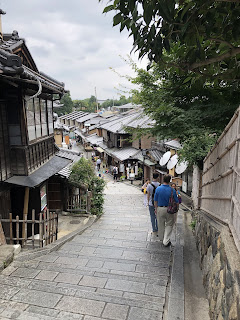Samurai and Ninja Museum - Bushido
I told you I'd go. How could I not! It's all about the history of Japan from the Samurai point of view. Hollywood movies don't do it justice. I mean, Tom Cruise as the Last Samurai?! 😕
Anyway, after I left the wonderful peacefulness of the temples, I took another long bus ride back toward the inn when I realized the bus was going right by where the museum is located. I got off at the next stop and walked through the Nishiki Market to get there.
Now I'm going to have to weave in some history here otherwise the photos, although cool, won't tell you much.
This "kago" above is actually a litter used to transport a person. No joke! The basket is only about 3 feet long and is attached to the single crossbeam that was then lifted and carried. There are little windows that had screens to protect from the elements. The kago was carried by a team of 4 men who took turns carrying it on their shoulders. They would go about 5-6 miles in one hour. The kago was used as transportation by samurai and the wealthy and was eventually replaced by the rickshaw. Honestly, I would have had a really tough time fitting in that thing and our guide told us that typical height of a samurai at that time was about 5 feet 5 inches. How did their swords fit?
These are actual samurai armours. The 4 on the right are over 300 years old!!
One of the presenters is a descendent of samurai and demonstrated kendo (sword fighting). He let us hold a katana that was over 300 years old.
Helmets had multiple pieces and the armour represented their clan so some would have animals or even animal hair (see the mustache) as part of the helmet.
You didn't become a samurai, you were born a samurai. There was a strict Feudal System with the Emperor on the top and craftsmen and merchants on the bottom. The Shogun had all the power, the Daimyo were the leaders of their clan (up to 140 of them at the time) and the Samurai were the noble class and represented 5-10% of each clan. Think Game of Thrones! Samurai owned small portions of land that the farmers worked.
At the top of this mountain, he found Chinese monks who were masters of martial arts. He learned from them and combined their skills with his own warrior skills and created one of the first schools of ninjatsu, which was the integration of different forms of martial arts. It eventually became what we think of as ninja today. This training became the training of the samurai.
Japan was basically isolated from outside trade other than with the Dutch and Korea. Dealings with Christian countries was seen as harmful because of their attempts to convert the Japanese. In 1853, US Commodore Matthew Perry threatened to fire his ship's guns if Japan didn't open its ports to trade with them. and eventually the Americans strong-armed the Japanese (agreements were made that were favorable for the Americans but not so favorable for the Japanese). This caused tension between the Emperor, Shogun and the clan leaders.
The Samurai stipends paid by the clan consumed half of Japan's yearly revenue and now, with the need of a modern army to fight the battleships of foreigners, there was no need for the old warrior class. They were slowly stripped of privileges and their livelihood was severely reduced. Saigo Takamori, seen below, was the Last Samurai. He disagreed with the emperor and shogun because of the changes and launched a samurai rebellion. The rebellion was crushed by the imperial army (it's totally Star Wars!) and Takamori committed seppuku (as a true samurai would) in 1877.


Overall it was a cool experience to see the exhibit. I was surprised at how much history I did know about Japan!
Anyway, after I left the wonderful peacefulness of the temples, I took another long bus ride back toward the inn when I realized the bus was going right by where the museum is located. I got off at the next stop and walked through the Nishiki Market to get there.
Now I'm going to have to weave in some history here otherwise the photos, although cool, won't tell you much.
This "kago" above is actually a litter used to transport a person. No joke! The basket is only about 3 feet long and is attached to the single crossbeam that was then lifted and carried. There are little windows that had screens to protect from the elements. The kago was carried by a team of 4 men who took turns carrying it on their shoulders. They would go about 5-6 miles in one hour. The kago was used as transportation by samurai and the wealthy and was eventually replaced by the rickshaw. Honestly, I would have had a really tough time fitting in that thing and our guide told us that typical height of a samurai at that time was about 5 feet 5 inches. How did their swords fit?
These are actual samurai armours. The 4 on the right are over 300 years old!!
Look at the detail!!
One of the presenters is a descendent of samurai and demonstrated kendo (sword fighting). He let us hold a katana that was over 300 years old.
Helmets had multiple pieces and the armour represented their clan so some would have animals or even animal hair (see the mustache) as part of the helmet.
You didn't become a samurai, you were born a samurai. There was a strict Feudal System with the Emperor on the top and craftsmen and merchants on the bottom. The Shogun had all the power, the Daimyo were the leaders of their clan (up to 140 of them at the time) and the Samurai were the noble class and represented 5-10% of each clan. Think Game of Thrones! Samurai owned small portions of land that the farmers worked.
The samurai lived by a code of honor called Bushido. Loyalty and honor above all with mercy, justice, courage, respect and honesty thrown in for good measure. The way of the samurai was to not only do things well but to do them perfectly. If not perfect, you are a failure, especially when it came to loyalty and honor to their Daimyo. If they failed, they were expected to commit seppuku (suicide by disembowelment) usually in front of a crowd. Only Ronin (technically still a samurai but they didn't belong to a clan and were out for hire) and above were allowed to carry a sword.
The first person to call themselves a samurai began over 1000 years ago when Kyoto was the capital. The emperor of the time asked four noble families to become his army to protect him because maintaining a big army was expensive. The four noble families were not content with their roles so they began fighting to gain more power and have more influence with the emperor. This lasted for hundreds of years (9th-12th century). Eventually one of the families won and the leader became the first Shogun. The Emperor was considered to be the descendent of the Sun Goddess so his life was never really threatened. This Shogun convinced the Emperor that he would take on the hard work of ruling Japan so they had all the power and the Emperor could enjoy an easy life. One of the leaders of a losing family, instead of committing seppuku, decided to climb a mountain and retire as a monk.At the top of this mountain, he found Chinese monks who were masters of martial arts. He learned from them and combined their skills with his own warrior skills and created one of the first schools of ninjatsu, which was the integration of different forms of martial arts. It eventually became what we think of as ninja today. This training became the training of the samurai.
Japan was basically isolated from outside trade other than with the Dutch and Korea. Dealings with Christian countries was seen as harmful because of their attempts to convert the Japanese. In 1853, US Commodore Matthew Perry threatened to fire his ship's guns if Japan didn't open its ports to trade with them. and eventually the Americans strong-armed the Japanese (agreements were made that were favorable for the Americans but not so favorable for the Japanese). This caused tension between the Emperor, Shogun and the clan leaders.
The Samurai stipends paid by the clan consumed half of Japan's yearly revenue and now, with the need of a modern army to fight the battleships of foreigners, there was no need for the old warrior class. They were slowly stripped of privileges and their livelihood was severely reduced. Saigo Takamori, seen below, was the Last Samurai. He disagreed with the emperor and shogun because of the changes and launched a samurai rebellion. The rebellion was crushed by the imperial army (it's totally Star Wars!) and Takamori committed seppuku (as a true samurai would) in 1877.


Overall it was a cool experience to see the exhibit. I was surprised at how much history I did know about Japan!



















Comments
Post a Comment